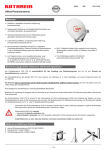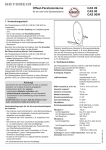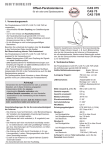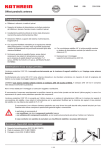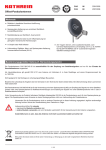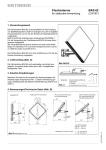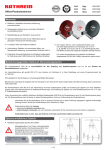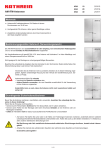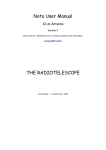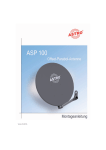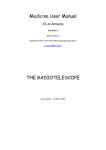Download Kathrein CAS 120
Transcript
Offset-Parabolantenne für ein, zwei oder drei Speisesysteme CAS 120 CAS 120/G CAS 120/R 1. Verwendungszweck Beachten Sie unbedingt die Angaben über die Grenzlast in den Technischen Daten (rechte Spalte). Bei Überschreitung der Grenzwerte können Teile losbrechen! Die Parabolantenne CAS 120 ist geeignet für die Verwendung mit – einem Speisesystem (LNB) zum Empfang der Signale von einem Satelliten oder – zwei oder drei Speisesystemen für MultifeedAnwendungen zum Empfang der Signale von zwei oder drei Satelliten mit 3°– 4° oder 6° Satellitenabstand. Die Speisesysteme sowie Hinweise zu deren Montage gehören nicht zum Lieferumfang der Parabolantenne. Achtung! Verwenden Sie die Parabolantenne nicht zu anderen Zwecken, als in dieser Anleitung angegeben. Insbesondere dürfen Sie niemals ● irgendwelche Bauteile verändern oder ● andere Bauteile verwenden, als vom Hersteller ausdrücklich für die Verwendung mit der Antenne vorgesehen. Andernfalls kann es sein, dass die Antenne nicht mehr ausreichend stabil und sicher ist ! Abb. 1 2. Technische Daten Die Parabolantenne CAS 120 erfüllt die Anforderungen gemäß EN 50083-1. Reflektordurchmesser: Breite: 1 234 mm Höhe: 1 335 mm Auslegung Tragarm: 1 160 mm max. von der Rohrmitte LNB-Aufnahme: Schwenkbare Haltevorrichtung für die Adapterplatte zur Montage von bis zu drei KathreinSpeisesystemen Maße verpackt (L x B x H): 1 500 x 1 335 x 225 mm Gewicht verpackt: 29 kg Gewicht unverpackt: 18,5 kg Mastdurchmesser: 50–90 mm Elevationseinstellung: 5°–50° Azimuteinstellung: 0°–360° Windfläche: 1,35 m2 Schwingungsfestigkeit: ETS 300019-2-4 (12.94) IEC Class 4 M 5 Windlast 1: 1 296 N bei Montagehöhe: bis 20 m über Grund bei Windgeschwindigkeit: bis 130 km/h bei Staudruck: 800 N/m2 Windlast 2: 1 776 N bei Montagehöhe: höher als 20 m über Grund (Faktor 1,37) bei Windgeschwindigkeit: bis 150 km/h Grenzlast 2 646 N bei Staudruck: 1 900 N/m2 (190 km/h) Achtung! Es können Teile losbrechen, wenn die Grenzlast überschritten wird! 936.2079/A/0206/1.8d Die Parabolantenne CAS 120 ist vorgesehen: – Ausschließlich für den Empfang von Satellitensignalen und – nur für den Einsatz als Haushaltsantenne. Als Haushaltsantenne gilt gemäß DIN 4131 eine Antenne mit höchstens 6 m freier Mastlänge und einem Einspannmoment bis zu 1650 Nm. – Für die Montage an nicht schwingungsanfälligen Bauwerken. Die Antenne darf nur gemeinsam mit der Halterung ZAS 120, Bestell-Nr. 218672, montiert werden. Die ZAS 120 gehört nicht zum Lieferumfang der Parabolantenne. 3. Bevor Sie… …die Parabolantenne montieren, anschließen oder verwenden, beachten Sie unbedingt die Hinweise in dieser Anleitung! Wenn Sie die Hinweise nicht beachten, können durch Fehler bei der Montage oder beim Anschluss Schäden an der Antenne oder am Montageort entstehen, können durch Fehlverhalten Gefahren für Ihre Gesundheit und Ihr Leben entstehen, haftet der Hersteller nicht für darauf zurückzuführende Fehlfunktionen und Schäden! Beachten Sie bei Arbeiten an Antennenanlagen auf Ihre Verantwortung Mitmenschen gegenüber! Heben Sie diese Anleitung für später auftretende Fragen auf und geben Sie diese bei einem Verkauf an den neuen Besitzer weiter! Vorsicht! Auf keinen Fall dürfen Sie unter Freileitungen Antennen montieren, andernfalls können vielleicht unbedingt erforderliche Mindestabstände unterschritten sein. Halten Sie auch zu den Seiten mindestens 1 m Abstand zu allen anderen elektrischen Einrichtungen ein! Es besteht Lebensgefahr, falls Sie oder metallische Antennenteile elektrische Einrichtungen berühren! Montieren Sie niemals Antennen auf Gebäuden mit leicht entzündbaren Dachabdeckungen, wie z. B. Stroh, Reet oder ähnlichen Materialien! Andernfalls besteht Brandgefahr bei atmosphärischen Überspannungen (statische Aufladung) oder Blitzentladungen (z. B. Gewitter). Abb. 2 Für einen einwandfreien Empfang muss eine freie „Sicht“ in Richtung Süden (+/- 20°) gewährleistet sein, bei einer Erhebung von etwa 30°. Dann stehen Ihnen folgende Satelliten zur Auswahl: 1 TÜRKSAT Position 42° Ost 2 ASTRA 2 Position 28,2° Ost 3 ASTRA 3 Position 23,5° Ost 4 ASTRA 1 Position 19,2 Ost 5 EUTELSAT W2 Position 16° Ost 6 EUTELSAT HOTBIRD Position 13° Ost 7 EUTELSAT W1 Position 10° Ost 8 EUTELSAT W3 Position 7° Ost 9 Thor Position 1° West 10 Telecom Position 5° West 11 HISPA-Sat Position 30° West Achten Sie darauf, dass sich keine Hindernisse zwischen der Parabolantenne und dem jeweiligen Satelliten befinden (z. B. Bäume, Dach- oder Hausecken, andere Antennen). Diese können den Empfang so beeinträchtigen, dass dieser bei ungünstiger Witterungslage völlig ausfällt. 4. Montageort wählen Der richtige Montageort ist entscheidend dafür, ob Ihre Parabolantenne sicher aufgebaut und optimal funktionieren kann. Bei der Montageortwahl sind bauwerkstypische Besonderheiten zu berücksichtigen. Bei Montage an Dach- und Gebäudekanten und zylindrischen Bauwerken ist gemäß DIN 1055, Teil 4 bzw. 4131, mit erhöhten Wind- oder Schwingungsbelastungen zu rechnen. Die dynamischen Eigenschaften der Antenne und des Bauwerks können sich gegenseitig beeinflussen und negativ verändern. Bei Nichtbeachtung kann eine Überschreitung der unter Punkt 2 genannten Grenzbelastung oder Schwingungsfestigkeit auftreten. Die Parabolantenne muss nicht unbedingt auf das Dach, weil es nicht auf die Höhe über Grund ankommt, sondern nur auf die freie „Sicht“ zum Satelliten. Deshalb kann ein geeigneter Montageort zum Beispiel auch im Garten, auf dem Balkon, auf der Terrasse, an einer Fassade oder an einer Garage zu finden sein. Abb. 2 936.2079/A/0206/2.8d Wenn also möglich, sollten Sie besser nicht auf dem Dach montieren. Sie verringern damit Ihren Arbeitsaufwand und die Gefahren bei Montagearbeiten auf dem Dach! Vorsicht! Bei der Montage der Parabolantenne können Gefahren für Ihr Leben und Ihre Gesundheit entstehen! Beachten Sie deshalb: 5. Antenne montieren (Abb. 4) Achten Sie bei der Montage des Antennenträgers (Standfuß, Mast oder Wandausleger) darauf, dass dieser senkrecht steht. Andernfalls kann die Ausrichtung der Antenne auf den Satelliten zu Schwierigkeiten führen. Die hier beschriebenen Montageschritte setzen gute handwerkliche Fähigkeiten und Kenntnisse vom Materialverhalten bei Windeinwirkung voraus. Lassen Sie die Arbeiten daher von einem Fachmann ausführen, wenn Sie nicht selbst über solche Voraussetzungen verfügen. Betreten Sie Dächer oder absturzgefährdete Stellen nur mit einem ordnungsgemäß angelegten intakten Sicherheitsgurt! Leitern oder andere Steighilfen müssen in einwandfreiem Zustand sein. Bauen Sie keine waghalsigen „Klettertürme“! Wenn Passanten durch herabfallende Gegenstände während der Montage gefährdet werden können, müssen Sie den Gefahrenbereich absperren! Achten Sie auf Freileitungen, falls solche in der Nähe des Montageortes vorbeiführen. Bei Berührung besteht akute Lebensgefahr! Arbeiten Sie niemals bei aufziehendem Gewitter oder während eines Gewitters an Antennenanlagen. Es besteht Lebensgefahr! Abb. 3 Abb. 4 a) Anforderungen an den Antennenträger Verwenden Sie nur Träger oder Tragrohre, die speziell für Antennenmontage geeignet sind. Andere Träger oder Rohre erfüllen möglicherweise nicht die erforderlichen Belastungsanforderungen. Wählen Sie für die Befestigung der Antennen Rohre mit einem Durchmesser von 60–90 mm und einer Wanddicke von mindestens 2 mm. Kathrein empfiehlt für die Montage folgende Bauteile: – Ebenerdig: Standfuß ZAS 15 – Wandmontage: Wandhalterung ZAS 16 – Dachmontage: Mastrohr ZAS 03 oder ZAS 04 Falls Sie doch auf dem Dach montieren, müssen Sie beachten, dass, entsprechend EN 50083-1, das zulässige Moment an der Einspannstellte maximal 1 650 Nm betragen darf. Daraus ergeben sich für die beiden Windlastfälle 1 und 2 die in Abb. 3 aufgeführten maximal zulässigen Mastlängen. Bei Überschreitung des Moments von 1 650 Nm an der Einspannstelle, z. B. durch einen längeren Mast und noch zusätzliche montierte Antennen, muss gemäß EN 50083-1 für die Gewährleistung der Sicherheit der baulichen Anlage und/oder des Gebäudes ein Statiker hinzugezogen werden. 936.2079/A/0206/3.8d Vergewissern Sie sich, ob das Dach Ihr Gewicht aushält. Betreten Sie niemals brüchige oder unstabile Flächen! Tragen Sie feste, rutschhemmende Schuhe! b) Halterung montieren (Abb. 5) Befestigen Sie die Azimut-/Elevationshalterung ZAS 120 wie aus der Abbildung ersichtlich. W Weitere Hinweise zur Montage der Halterung ZAS 120 entnehmen Sie dem dort beiliegenden Anwendungshinweis. Falls Sie beabsichtigen, die Antenne nicht auf der Mastspitze zu montieren, müssen Sie vorher den Auflagewinkel W von der Halterung abschrauben. Abb. 5 c) Antenne vorbereiten (Abb. 6) 1. Die vier Schrauben aus den Sicherungsholzleisten herausdrehen. Entfernen Sie für die weiteren Montageschritte die Kartonhülle noch nicht. Sie dient zum Schutz der Speisesystemhalterung. Den Ausleger soweit herausschwenken bis er am Kartonrand aufliegt. 2. Parabolspiegel anheben. Dadurch schwenkt der Ausleger weiter, bis er in die Verriegelung V einrastet. S V 3. Die vier Schrauben S (SW 19) anziehen. Anziehdrehmoment 37–43 Nm. Abb. 6 936.2079/A/0206/4.8d 4. Hängen Sie die vorbereitete Antenne in die Halterung ZAS 120 ein. d) Speisesystem (LNB) Die Speisesysteme sowie Hinweise zu deren Montage gehören nicht zum Lieferumfang der Parabolantenne. Entnehmen Sie daher die näheren Informationen zur sachgerechten Montage den Anleitungen, die dem jeweiligen Speisesystem beiliegen. Abb. 7 An der schwenkbaren Haltevorrichtung am Tragarm können über die Adapterplatte ein, zwei oder drei Kathrein-Speisesystem montiert werden. Auf der Adapterplatte zeigen die Markierungen – 3 die Montageposition für ein Speisesystem, – 2 und 4 die Montageposition für zwei Speisesysteme (Multifeed) bei 3°– 4° Satellitenabstand, – 1 und 5 die Montageposition für zwei Speisesysteme (Multifeed) bei 6° Satellitenabstand. Bei Belegung der Positionen 1 und 5 kann auch zusätzlich mittig auf Position 3 ein Speisesystem montiert werden (3 Satelliten mit jeweils 3° Abstand) Abb. 7 Satellit A Satellit B Abb. 8 Beispiel für Montagepositionen bei MultifeedAnwendung mit 3°-4° Satellitenabstand. Pos. 2 ASTRA 19,2° Ost ASTRA 23,5° Ost EUTELSAT 16° Ost HOTBIRD 13° Ost EUTELSAT 10° Ost + + + + + Pos. 4 EUTELSAT 16° Ost ASTRA 19,2° Ost HOTBIRD 13° Ost EUTELSAT 10° Ost EUTELSAT 7° Ost B A Abb. 8 mit 6° Satellitenabstand. + + + + (Pos. 3) (ASTRA 19,2° Ost) (EUTELSAT 16° Ost) (HOTBIRD 13° Ost) (EUTELSAT 10° Ost) + + + + Pos. 5 EUTELSAT 16° Ost HOTBIRD 13° Ost EUTELSAT 10° Ost EUTELSAT 7° Ost Tipp! Bei Multifeed-Anwendungen sollte die Antenne auf den Satelliten ausgerichtet werden, der die pegelschwächsten Signale sendet. 936.2079/A/0206/5.8d Pos. 1 ASTRA 23,5° Ost ASTRA 19,2° Ost EUTELSAT 16° Ost HOTBIRD 13° Ost 6. Polarisationsvoreinstellung (Abb. 9) Ein Speisesystem (Monofeed) In Abhängigkeit Ihres Standortes und der Position des zu empfangenden Satelliten stellen Sie am Speisesystem den Polarisationswinkel entsprechend Tabelle (siehe Speisesystem) ein. Die schwenkbare Haltevorrichtung H verbleibt dabei in der Nullposition. Mehrere Speisesysteme (Multifeed) Bei Multifeed-Anordnung ist die schwenkbare Haltevorrichtung H entsprechend beiliegender Azimut/Elevationstabelle für Multifeed-Anwendung um den Winkel V zu schwenken. In diesem Falle ist der Polarisationswinkel am Speisesystem nicht nach dieser Tabelle, sondern nach einem zu berechnenden Korrekturwinkel einzustellen: PWNEU = PWTAB - V Abb. 9 7. Antenne ausrichten (Abb. 10) Die Antenne muss sowohl von der Richtung (Azimut), als auch von der Neigung (Elevation) her genau auf den Satelliten ausgerichtet sein. Bei Multifeed-Lösungen sollte die Antenne auf den Satelliten mit dem schwächsten Signalpegel ausgerichtet werden. a) Neigung (Elevation) einstellen Beim Schwenken der Antenne um die Elelvationsachse müssen die 6 Schrauben A locker sein. Stellen Sie nun die Neigung ein. Den genauen Elevationswinkel für Ihren Standort finden Sie in der Anleitung für das Speisesystem. Stellen Sie diesen Winkel an der Skala (10° bis 50°) ein. Dabei muss der entsprechende Skalenstrich auf der Halterung mit der Kante C des Reflektorhaltebleches fluchten. Ziehen Sie die Schrauben A leicht an. Abb. 10 936.2079/A/0206/6.8d Wenn Sie die Antenne per Hand leicht ankippen, können Sie zum Grob- oder Voreinstellen des Elevationswinkels die Mutter B (für Feineinstellung) schneller drehen. b) Richtung (Azimut) einstellen Für die folgenden Schritte benötigen Sie gegebenenfalls einen Helfer, falls Sie nicht selbst an einem AntennenMessgerät oder Bildschirm mit angeschlossenem Satelliten-Receiver das Ergebnis der Ausrichtarbeiten beobachten können. Stellen Sie am Satelliten-Receiver einen bekannten Programmplatz ein, um kontrollieren zu können, ob Sie auch wirklich den gewünschten Satelliten ”getroffen” haben. Drehen Sie die Antenne grob in Richtung Süden. Drehen Sie danach die Antenne langsam um die Mastachse – nach links und rechts, bis das eingestellte Programm am besten zu empfangen ist. c) Feineinstellung Lösen Sie die Schrauben A der Elevationsfixierung. Schwenken Sie die Antenne leicht nach oben und nach unten durch Drehen der Feineinstellmutter B, bis Sie – entweder am Antennen-Messgerät das stärkste Signal messen – oder bei optischer Beurteilung am Bildschirm den besten Bildeindruck erzielen (nur bei Analogempfang): Hierzu schwenken Sie die Antenne soweit nach oben und unten, bis Sie jeweils an die Grenze kommen, wo die ersten sogenannten „Fischchen“ (Spikes) am Bildschirm erscheinen. Stellen Sie die Antenne dann in die Mitte zwischen diesen beiden Grenzpunkten. Achtung! Kontrollieren Sie nach außergewöhnlichen Belastungen (schweren Stürmen, ungewöhnlich starke Vereisung, außergewöhnlichen Vorkommnissen) den Befestigungszustand der Antenne. d) Antenne endgültig festschrauben Ziehen Sie am Ende alle Schraubverbindungen fest. Kontrollieren Sie zum Schluss noch einmal alle Schraubverbindungen auf festen Sitz. Die Antennenkabel sind an solchen Stellen mit Kabelbindern zu befestigen, wo die Gefahr besteht, dass sie durch Windbewegungen scheuern und dadurch beschädigt werden können. 936.2079/A/0206/7.8d Korrigieren Sie nun abwechselnd die Richtung (Azimut) und Neigung (Elevation), bis sich das Messoder Bildergebnis nicht mehr verbessert. Hinweis: Beim Festdrehen der Flügelmuttern an den zwei Schließschellen der Halterung kann sich die Antenne leicht verdrehen! Dies sollten Sie bei der Feineinstellung beachten (und eventuell für eine ganz genaue Einstellung ausnutzen). Gegebenenfalls optimieren Sie am Ende nochmals den (die) Polarisationswinkel des (der) Speisesystem(e)s und den Winkel der schwenkbaren Haltevorrichtung zur Speisesystembefestigung. Warnung! Erdungs- und Blitzschutzarbeiten dürfen wegen der Gefahr unzulänglicher Arbeitsergebnisse nur von hierfür speziell geschulten Fachkräften des Elektrohandwerks ausgeführt werden! Potenzialausgleichsschiene Netzanschluss 230 V Erdungsleitung Potenzialausgleichleitung 7. Antenne erden/Blitzschutz Deshalb müssen der Mast und die Außenleiter der Antennenkabel auf kürzestem Weg senkrecht über einen geeigneten Erdungsleiter mit der Blitzschutzanlage des Gebäudes verbunden sein (falls keine Blitzschutzanlage vorhanden ist: mit der Gebäudeerdung). a) Geeignet als Erdungsleiter – ist ein Einzelmassivdraht mit einem Querschnitt von min. 16 mm2 Kupfer, min. 25 mm2 Aluminium oder min. 50 mm2 Stahl – oder metallische Hausinstallationen (z. B. durchgehende Metallrohre der Wasser- oder Heizungsanlage), sofern diese vom Querschnitt und der Dauerhaftigkeit der elektrischen Verbindung her mindestens den Anforderungen an Erdungsleiter entsprechen. b) Nicht geeignet als Erdungsleiter – sind die Außenleiter der Antennenkabel – oder Schutzleiter oder Neutralleiter des Starkstromnetztes. Potenzialausgleichsschiene Erdungsanschluss Im schraffierten Bereich ist lt. Norm eine Antennenerdung nicht zwingend erforderlich. c) Führung von Erdungsleitern Antennenkabel und Erdungsleiter dürfen nicht durch Räume geführt werden, die zur Lagerung von leicht entzündlichen Stoffen dienen (z. B. Heu, Stroh) oder in denen sich eine explosive Atmosphäre bilden kann (z. B. Gase, Dämpfe). Bei Verwendung der Parabolantenne in kompletten Antennenanlagen (z. B. Verteilanlagen) müssen zudem die Erdungsmaßnahmen so ausgeführt sein, dass der Erdungsschutz auch dann bestehen bleibt, wenn einzelne Einheiten entfernt oder ausgetauscht werden. KATHREIN-Werke KG · Anton-Kathrein-Straße 1–3 · Postfach 10 04 44 · D-83004 Rosenheim · Deutschland · Telefon (0 80 31) 18 40 · Telefax (0 80 31) 18 43 06 Technische Änderungen vorbehalten. Die Antenne muss geerdet werden, so fordert es die EN 50083-1. Hiervon ausgenommen sind nur solche Außenantennen, – die mehr als 2 m unterhalb der Dachkante – und zugleich weniger als 1,5 m von Gebäuden angebracht sind. Ungeachtet dessen empfiehlt Kathrein generell aus Sicherheitsgründen einen Potenzialausgleich vorzunehmen. Gefahren können nicht nur durch Gewitter entstehen (Blitzschlag), sondern auch durch statische Aufladung oder Kurzschluss in den angeschlossenen Geräten: Potenzialausgleichleitung 936.2079/A/0206/8.8d/SKS Führen Sie niemals Erdungs- und Blitzschutzarbeiten durch, wenn Sie nicht selbst Fachkraft mit entsprechenden Kenntnissen sind! Die hier abgedruckten Hinweise sind keine Aufforderung an Nichtfachleute, Erdungs- und Blitzschutzarbeiten in eigener Verantwortung durchzuführen, sondern dienen der von Ihnen beauftragten Fachkraft als zusätzliche Information! Offset parabolic antenna for one, two or three feed systems CAS 120 CAS 120/G CAS 120/R 1. Intended use The parabolic antenna CAS 120 is exclusively destined for: – reception of satellite signals and – utilisation as a domestic antenna. A domestic or private antenna is defined acc. to DIN 4131 as an antenna with a free mast length of 6 m and a bending moment at the fixing point of up to 1650 Nm. – installation on buildings not subject to oscillations. The ZAS 120 is not included in the scope of delivery of the parabolic antenna. It is important to observe the maximum load as mentioned in the technical data (right column). If that value is exceeded, antenna parts can break loose! The parabolic antenna CAS 120 can be equipped with – one feed system (LNB) for reception of signals from one satellite. – two or three feed systems for multifeed reception from two or three satellites 3°– 4° or 6° apart. Neither the feed systems nor the mounting instructions for the feed systems are included in the scope of delivery of the antenna. Attention! Do not use the parabolic antenna for purposes other than mentioned in these instructions. Never ● modify any antenna parts or ● use different components than those specifically recommended by the manufacturer for use with these antennas. As a result of that, the stability and security of the antenna can be affected. Fig. 1 2. Technical data The parabolic antennas CAS 120 complies with the specifications acc. to DIN EN 50083-1. Diameter of reflector: Width: 1234 mm Height: 1335 mm Length of the support arm: 1160 mm max. from centre of mast LNB support: Swivelling support for the adapter plate for mounting up to 3 Kathrein feed systems Measurements (packed): 1500 x 1335 x 225 mm Weight (packed): 29 kg Weight (unpacked): 18.5 kg Diameter of mast: 50-90 mm Elevation angle: 5°-50° Azimuth angle: 0°-360° Wind surface area: 1.35 m2 Vibration immunity: ETS 300019-2-4 (12.94) IEC Class 4 M 5 Windload 1: 1296 N for an installation height: up to 20 m above ground for a wind velocity: up to 130 km/h at a dynamic pressure: 800 N/m2 Windload 2: 1776 N for an installation height: higher than 20 m above ground (factor 1.37) for a wind velocity: up to 150 km/h Maximum load: 2646 N at a dynamic pressure: 1900 N/m2 (190 km/h) Attention! If the max. load is exceeded, antenna parts can break loose! 936.2079/A/0206/1.8e The antenna may only be mounted with the support ZAS 120, order. no 218672. 3. Before you… begin to install, connect or utilise the parabolic antenna, observe the information you find in these mounting instructions. If you fail to pay attention to the information, one cannot exclude that due to wrong installation and connecting, or because of having modified components or using other components, the antenna or the mounting place will be damaged. that because of inappropriate behaviour, risks for your and other people's health and life will be created. that the manufacturer will decline the liability for faulty function and resulted damages. It is most important that you are aware of the responsibility you have for your own and other people's safety when working on the antenna system! Retain these instructions for possible later use when questions come up. In case you sell the antenna, pass the instructions on to the new owner. Position Position Position Position Position Position Position Position Position Position Position 42° East 28.2° East 23.5° East 19.2° East 16° East 13° East 10° East 7° East 1° West 5° West 30° West Unobstructed "visibility" means that there must be no obstacles (such as trees, buildings, roofs, balconies or similar obstacles) between the antenna and the satellite. Obstacles of this kind can impair the reception or even make reception impossible. South West The selection of the right mounting site for your antenna is important in order to ensure safe and satisfactory operation. When choosing the mounting site, pay attention to typical characteristics of the building. If the antenna is installed on the edge of a roof or building, one must reckon acc. to DIN 1055, Part 4 or 4131 with a higher wind or oscillation load. This means that the dynamic characteristics of the antenna and the building can influence each other and change the characteristics negatively. Disregard of these circumstances can lead to exceeding the max. load or dynamic strength mentioned in sect. 2. It is not essential to mount the parabolic antenna on the roof since it is not height above ground that matters but an unimpeded line-of-sight to the satellite. Thus a suitable mounting location may be found in the garden, on the balcony/terrace or on a facade or garage, for example. Thus, if at all possible, the roof should be avoided as a mounting location. In any event this reduces the amount of work and avoids the dangers of doing installation work on the roof! 936.2079/A/0206/2.8e Never install the antenna below overhead power lines. It can be that the required safety distance is not kept. Furthermore, make sure that the lateral distance to all other electrical systems is at least 1 m. Danger to life exists if you or the antenna make contact with live parts! Do not install the antenna on buildings with easily inflammable roofs (straw, reed or similar material). This is a fire hazard since the antenna is subject to static charge and lightning. Fig. 2 1 TÜRKSAT 2 ASTRA 2 3 ASTRA 3 4 ASTRA 1 5 EUTELSAT W2 6 EUTELSAT HOTBIRD 7 EUTELSAT W1 8 EUTELSAT W3 9 Thor 10Telecom 11 HISPA-Sat 4. Mounting site Attention! East Fig. 2 For good reception the antenna must have an unobstructed "visibility" to the south (+/-20). The horizontal elevation angle must be 30°. The reception of the following satellites will then be possible: 5. Installation of the antenna (Fig. 4) Attention! The installation work can create dangers for your health and life. Therefore: Make sure that the antenna support (foot mount, mast or wall bracket) is installed in a vertical position, otherwise the alignment of the antenna to the satellite can create problems. The mounting procedure described here demands skills and a knowledge how the antenna behaves when being subjected to atmospheric conditions. If you do not have the required skills, ask a specialist to do the installation work. When working on the roof or near to drop away sites, use a safety belt. Make sure that the roof will support your weight. Wear non-slip shoes! Use ladders or other climbing aids that are in perfect condition. If passers-by can be hurt by falling objects, block the danger area. Watch out for overhead power lines. Getting into contact with these means danger to life! Never work on the antenna during a thunderstorm or when one is approaching. This can put your life at risk! Fig. 4 a) Requirements for the antenna support Only use masts or supports specially suited to be used as an antenna support. Other supports often do not have the necessary strength required for the environmental conditions. Choose a mast that has a diameter of 60-90 mm and a wall thickness of at least 2 mm. For mounting, Kathrein Werke KG recommends the following components: - Ground mounting: Tripod ZAS 15 - Wall mounting: Wall support ZAS 16 - Roof mounting: Mast ZAS 03 or ZAS 04 When mounting takes place on the roof, keep in mind that the maximal admissible bending moment on the fixing point is 1650 Nm according to EN 50083-1. From this, the maximal admissible mast lengths, which are listed in Fig. 3, are determined for windload 1 and windload 2. In the case of a greater bending moment than 1650 Nm on the fixing point, for example, due to a longer mast and additionally mounted antennas, a static engineer is required to guarantee safety of the system and/or building according to EN 50083-1. Lmax Fig. 3 Windload up to 20 m above ground Windload (> 20 m above ground) 1.1 m 0.75 m 936.2079/A/0206/3.8e Fixing point b) Mounting the support arm (Fig. 5) Installation on top of mast Mount the azimuth/elevation support arm ZAS 120 on the mast as shown in the drawing. Installation in front of mast W Remove Refer to the operating instructions supplied with the ZAS 120 for more information regarding installation. If you do not intend to mount the antenna on the top of the mast, you must first remove the support angle W from the support arm. Fig. 5 c) Preparing the antenna (Fig. 6) 1. Remove the four screws from the protective strip of wood. For the following mounting steps, do not remove the carton yet. It protects the feed system support. Swing out the arm until it lies on the edge of the carton. 2. Lift up the parabolic antenna. The arm continues to swing out until it is fixed in the lock V. S V 3. Tighten the four screws S (SW 19). Tightening torque 37-43 Nm. Fig. 6 936.2079/A/0206/4.8e 4. Connect the prepared antenna to the support ZAS 120. d) Feed system (LNB) The feed systems and their mounting instructions are not in the scope of the delivery of the parabolic antenna. Detailed information for the correct installation is supplied together with each feed system. Fig. 7 One, two or three Kathrein feed systems can be mounted on the swivelling multifeed support on the support arm via the adapter plate! The marking on the adapter plate indicates – 3 as the mounting position for one feed system, – 2 and 4 as the mounting positions for two multifeed systems allowing signal reception from satellites 3°-4° apart, – 1 and 5 as the mounting positions for two multifeed systems allowing signal reception from satellites 6° apart. When using positions 1 and 5, a feed system can also be additionally mounted in the middle on position 3 (3 satellites 3° apart). Fig. 7 Satellite A Satellite B Fig. 8 Example for mounting positions for multifeed reception with satellites 3°-4° apart. Pos. 2 ASTRA 19,2° East ASTRA 23,5° East EUTELSAT 16° East HOTBIRD 13° East EUTELSAT 10° East + + + + + Pos. 4 EUTELSAT 16° East ASTRA 19,2° East HOTBIRD 13° East EUTELSAT 10° East EUTELSAT 7° East B A Fig. 8 with satellites 6° apart. + + + + (Pos. 3) (ASTRA 19,2° East) (EUTELSAT 16° East) (HOTBIRD 13° East) (EUTELSAT 10° East) + + + + Pos. 5 EUTELSAT 16° East HOTBIRD 13° East EUTELSAT 10° East EUTELSAT 7° East Tip! With multifeed applications the antenna should be aligned to the satellite with the weaker signal level. 936.2079/A/0206/5.8e Pos. 1 ASTRA 23,5° East ASTRA 19,2° East EUTELSAT 16° East HOTBIRD 13° East 5. Setting polarisation angle (Fig. 9) Sense of rotation for polarisation angle One feed system (mono feed) Adjust the polarisation angle according to the tables (see feed system) on the feed system depending on your mounting site and the position of the received satellites. The swivelling support H remains in the zero position. Mounting several feed systems (multifeed) For multifeed reception, the swivelling support H must be moved to the angel V according to the supplied azimuth/elevation table for multifeed reception. In this case, the polarisation angle on the feed system is not adjusted according to this table, but rather to the calculated correction angle : PWNEW = PWTAB - V Sense of rotation for the angle V for swivelling part Fig. 9 7. Aligning the antenna (Fig. 10) With regard to the direction (Azimuth) and the inclination (Elevation), the antenna must be accurately aligned to the satellite. For multifeed reception, it is necessary to align the antenna to the satellite with the weaker signal level. a) Setting the inclination (Elevation) When setting the elevation of the antenna, loosen the 6 screws A on the elevation scale. Now set the elevation. You find the correct angle of the elevation for your mounting site in the mounting instructions supplied with the feed system. Set this angle on the scale (10° to 50°). Here, the respective scale line on the support must be aligned with the edge C of the reflector support sheet. Lightly screw on the screws A. Fig. 10 936.2079/A/0206/6.8e When you lightly tilt the antenna by hand, you can turn the nut B (for fine adjustment) faster for rough adjustment or pre-adjustment of the elevation angle. b) Setting the direction (Azimuth) For the following steps you need an assistant if you cannot operate an antenna measuring instrument nor watch on your television set which you have connected to a satellite receiver the result of your alignment work. Select on your satellite receiver a programme well known in order to make sure you are aligned to the desired satellite. Roughly align the antenna towards the south. Then slowly turn the antenna around the mast axle to the left and then to the right, until you obtain the best picture for the chosen programme. Zenith Elevation angle – the strongest signal is shown on the measuring instrument – or best picture quality is obtained on the TV set (only for analogue reception): Move the antenna slightly up and down until you see the first "spikes" on the screen of your TV set. The best picture quality will be found in the middle of these boundary positions. Now alternately correct the direction (Azimuth) and the inclination (Elevation) until there is no more improvement of the measured value or the picture quality. on riz Ho c) Fine alignment Loosen again the screws A on the elevation scale. Move the antenna slightly up and down by turning the fine wing nut B, until East West Azimuth angle South Attention! Check if the antenna is properly secured after unusual conditions (bad storms, heavy ice build-up, etc.). Note: On tightening-up the nuts on the mast clamp, a slight movement of the antenna may occur! You need to take this into account during fine adjustment (and exploit it to get a very precise adjustment if need be). Also, optimise the polarisation angle(s) of the feed system(s) and the angle of the swivelling support once more. 936.2079/A/0206/7.8e d) Final tightening up of antenna Finally, tighten all screws. Check again that all screw connections have been done properly. Secure the cable using cable ties along the full length of the antenna carrier so that it does not chafe and sustain damage due to wind effects. Attention! Due to the danger of inadequate results from grounding and lightning conductor work, only electricians with the requisite specialised training must undertake this! Never undertake grounding and lightning conductor work yourself unless you are a specialist with the necessary know-how! The instructions supplied here are not an invitation to non-specialists to take responsibility for carrying out grounding and lightning conductor work themselves, but serve as additional information for the specialist. Equipotential bonding strip Mains connection 230 V Grounding conductor Equipotential bonding conductor 7. Antenna grounding/Lightning protection The antenna must be grounded as is required by standard DIN EN 50083-1. The only external antennas exempted from this are those: Equipotential bonding conductor Equipotential bonding strip Grounding connection – fitted more than 2 metres below the crest of the roof – and also less than 1.5 metres from the building. a) Suitable as grounding conductor: – a single solid wire with a min. cross-section of at least 16 mm2 for copper, 25 mm2 for aluminium or 50 mm2 for steel – or metallic domestic installations (continuous metallic water or heating system pipes, for example) provided that they at least meet the requirements for grounding conductors in terms of cross-section and permanence of the electrical connection. c) Routing of grounding conductors Antenna cables and grounding conductors must not be routed through rooms used for storing easily inflammable substances (hay or straw, for example) or in which an explosive atmosphere can develop (gases, vapours). If the parabolic antenna is used in integrated antenna systems (e. g. distribution systems), the grounding measures must also be designed in such a way that grounding protection is still maintained if individual units are removed or replaced. b) Not suitable as grounding conductor: – the external conductors of the antenna cable – or the grounding conductor or neutral conductor of the power system KATHREIN-Werke KG · Anton-Kathrein-Straße 1–3 · Postfach 10 04 44 · D-83004 Rosenheim · Deutschland · Telefon (0 80 31) 18 40 · Telefax (0 80 31) 18 43 06 Subject to technical modifications. Consequently, the mast and the external conductor of the antenna cable must be connected to the building's lightning conductor system taking the shortest path vertically via a suitable grounding conductor (or to the building's grounding system if no lightning conductor system is available). Grounding the antenna installed in the hatched area is not explicitly required by standard 936.2079/A/0206/8.8e/SKS However, for safety reasons Kathrein recommends to mount a potential equalisation device. Danger can arise not just from thunderstorms (lightning strikes) but also through static charge accumulation or discharge in the devices attached: Antenna parabolique offset prévue pour une, deux ou trois têtes SHF CAS 120 CAS 120/G CAS 120/R 1. Objectif L’antenne parabolique CAS 120 est prévue: – exclusivement pour la réception de signaux satellite et – uniquement en tant qu’antenne domestique. Selon la norme DIN 4131, la longueur du mât d’une antenne domestique ne doit pas dépasser 6 m et son moment de flexion doit être inférieur à 1650 Nm. – pour le montage sur des supports non susceptibles d’osciller. L’antenne doit être installée seulement conjointement avec le support ZAS 120, Réf. 218672. Le support n’est pas livré avec l’antenne parabolique. Fig. 1 En cas de dépassement, bris de pièces possible! L’antenne parabolique CAS 120 est utilisable avec – une tête SHF (LNB) pour la réception des signaux d’une position de satellite – deux ou trois têtes SHF pour réception multisatellite des signaux de deux ou trois positions satellite séparées d’un écart de 3°– 4° ou 6°. Les têtes SHF et les instructions pour le montage ne sont pas livrées avec l’antenne parabolique. Attention! N’employez pas l’antenne parabolique pour d’autres buts que ceux indiqués dans cette notice. En particulier, vous ne devez jamais ● modifier quelque pièce que ce soit ou ● employer d’autres pièces que celles prévues par le fabricant. Dans le cas contraire, cela peut compromettre la stabilité et la sécurité de l’antenne! L’antenne parabolique CAS 120 satisfait aux exigences de la norme EN 50083-1. Diamètre du réflecteur: Largeur: 1234 mm Hauteur: 1335 mm Longueur du bras support: 1160 mm max. du milieu du mât Support pour LNB: Support orientable pour la plaque adaptateur qui permet de monter jusqu’à 3 têtes SHF Kathrein Dimensions emballé (L x I x H): 1500 x 1335 x 225 mm Poids brut: 29 kg Poids net: 18,5 kg Diamètre du mât: 50-90 mm Réglage de l’élévation: 5°-50° Réglage de l’azimut: 0°-360° Surface au vent: 1,35 m2 Résistance aux oscillations: ETS 300019-2-4 (12.94) IEC Class 4 M 5 Charge au vent 1: 1296 N si montage en hauteur: jusqu’à 20 m au-dessus du sol avec vitesse du vent: jusqu’à 130 km/h avec pression dynamique: 800 N/m2 Charge au vent 2: 1776 N si montage en hauteur: supérieur à 20 m au dessus du sol (facteur 1,37) avec vitesse du vent: jusqu’à150 km/h Charge limite: 2646 N avec pression dynamique: 1900 N/m2 (190 km/h) Attention! Bris de pièces possible en cas de dépassement de la charge limite! 936.2079/A/0206/1.8f 2. Caractéristiques techniques Tenez compte impérativement des indications relatives à la charge limite mentionnées dans les caractéristiques techniques (colonne ci-contre). Avant de monter, brancher ou employer l’antenne parabolique, observez obligatoirement les conseils de cette notice! Dans le cas contraire, ● des erreurs de montage ou de branchement peuvent abîmer l’antenne ou endommager le lieu de montage, ● votre santé ou votre vie peuvent être mises en danger suite à un comportement inadapté, ● le fabricant n’assume aucune responsabilité pour les dégâts et dysfonctionnements en résultant. Lors de travaux sur des antennes, veuillez prendre en considération votre responsabilité envers toute autre personne. Conservez la notice pour pouvoir la consulter plus tard si nécessaire et, en cas de vente, remettez-la au nouveau propriétaire. Attention! Vous ne devez en aucun cas monter l’antenne en dessous de lignes électriques aériennes, sinon il se peut que les écarts obligatoirement nécessaires ne soient pas respectés. Maintenez également sur les côtés un écart d’au moins 1 m avec toutes les autres installations électriques! Danger de mort si des pièces métalliques de l’antenne touchent des installations électriques: Ne montez jamais l’antenne sur des bâtiments avec des couvertures de toit facilement inflammables, comme p. ex. paille, chaume ou autres matériaux semblables! Dans le cas contraire, il y a des risques d’incendie en cas de surtensions atmosphériques (chargement d’électricité statique) ou de foudre (p. ex. orage). Sud Est Ouest Fig. 2 Pour une réception parfaite, vous devez vous assurer d’avoir une „vue“ dégagée en direction du sud (+/-20°) avec une inclinaison d’environ +30°. Vous avez alors le choix parmi les satellites suivants: 1 TÜRKSAT 2 ASTRA 2 3 ASTRA 3 4 ASTRA 1 5 EUTELSAT W2 6 EUTELSAT HOTBIRD 7 EUTELSAT W1 8 EUTELSAT W3 9 Thor 10 Telecom 11 HISPA-Sat Position Position Position Position Position Position Position Position Position Position Position 42° Est 28.2° Est 23.5° Est 19.2° Est 16° Est 13° Est 10° Est 7° Est 1° Ouest 5° Ouest 30° Ouest ● Veillez à ce qu’il n’y ait pas d’obstacles entre l’antenne parabolique et le satellite voulu (p. ex. des arbres, un coin de toit ou de maison, d’autres antennes). Cela pourrait perturber la réception au point qu’en cas de conditions atmosphériques défavorables la réception ne soit plus du tout possible. 4. Choix du lieu de montage Le lieu de montage correct est l’élément décisif pour une installation sûre et un fonctionnement optimale de l’antenne parabolique. Tenez compte des caractéristiques du support pour choisir le lieu de montage. En cas de montage sur les bords d’un toit ou d’un bâtiment et avec des supports cylindriques, il convient de tenir compte de charges élévées dues au vent ou à des oscillations conformément à la norme DIN 1055, partie 4 ou DIN 4131. Les caractéristiques dynamiques de l’antenne et du support peuvent s’influencer et interagir négativement. En cas de non-observation, il peut se produire un dépassement de la charge limite mentionnée au point 2 ou de la résistance aux oscillations. L’antenne parabolique ne doit pas obligatoirement être montée sur le toit, car ce qui compte n’est pas la hauteur au-dessus du sol mais uniquement la „vue“ dégagée vers le satellite. C’est pourquoi un lieu de montage approprié peut se trouver également dans le jardin, sur le balcon, sur la terrasse, sur une façade ou sur le mur d’un garage. Si cela est possible, vous devriez au mieux éviter de monter sur le toit. Aprés tout, vous aurez moins de travail et moins de risques qu’avec une installation de l’antenne sur le toit! Fig. 2 936.2079/A/0206/2.8f 3. Conseils préliminaires Attention! Lors du montage de l’antenne parabolique, votre santé et votre vie peuvent être mises en danger! C’est pourquoi observez ceci: Les étapes de montage décrites ici présupposent de bonnes capacités de bricolage et la connaissance du comportement des matériaux sous l’influence du vent. Demandez à un spécialiste de réaliser ces travaux si vous ne disposez pas vous-même de ces facultés. 5. Montage de l’antenne (Fig. 4) Faites attention lors du montage du support de l’antenne (mát trépied, mât ou bras mural) que ce dernier soit vertical, car dans le cas contraire cela peut entraîner des difficultés pour positionner l’antenne vers le satellite. Déplacez-vous sur les toits ou à des endroits avec des risques de chute uniquement après avoir mis une cinture de sécurité en bon état. Assurez-vous que le toit puisse supporter votre poids. Ne marchez jamais sur des surfaces fragiles ou instables! Portez des chaussures fermées et antidérapantes! Les échelles ou moyens d’escalade doivent être en parfait état. Ne construisez pas d’échafaudage hasardeux! Si des passants peuvent être mis en danger par des objets tombant du toit pendant le montage de l’antenne, vous devez interdire l’accès à la zone de danger! Faites attention aux lignes électriques aériennes qui pourraient se trouver à proximité du lieu de montage. Danger de mort imminent en cas de contact! N’effectuez aucuns travaux sur une antenne en cas d’orage imminent ou pendant un orage. Danger de mort! Fig. 4 a) Conditions requises pour le support de l’antenne N’employez que des mâts ou tubes porteurs qui sont prévus spécialement pour le montage d’antenne. D’autres tubes ou supports n’ont plus souvant pas la résistance exigée aux influences du vent et des intempéries. Choisissez un diamétre de tube entre 60 et 90 mm avec une épaisser de paroi d’au moins 2 mm. Kathrein recommande pour le montage les supports suivants: - Sur le sol: Mât trépied ZAS 15 - Sur le mur: Support mural ZAS 16 - Sur le toit: ZAS 03 ou ZAS 04 En cas de montage de l’antenne sur le toit, vous devez observer selon EN 50083-1 que le moment de flexion admissible au point de fixation ne dépasse pas 1650 Nm. Pour les cas 1 et 2 de la charge au vent, la Fig. 3 indique les longueurs max. admissible du mât. Au cas où le moment de flexion de 1650 NM est dépassé, p. ex. en raison d’un mât plus long ou le montage d’autres antennes, il est nécessaire de consulter un statisticien afin d’assurer la sécurité de l’édifice en conformité avec EN 50083-1. Lmax Fig. 3 Charge au vent 1 (jusqu’à 20 m au-dessus du sol) Charge au vent 2 (> 20 m dessus du sol) 1.1 m 0.75 m 936.2079/A/0206/3.8f Point de fixation b) Montage du support (Fig. 5) Montage au bout Montez le support Azimut/Elévation ZAS 120 comme cela est indiqué dans le dessin. Montage devant le mât W Enlevez Vous touvez plus d’information pour le montage du support ZAS 120 dans la notice livrée avec le support. Si vous ne voulez pas monter l’antenne au bout du mât, il faut d’abord dévisser la plaque d’appui angulaire W du support. Fig. 5 c) Préparation de l’antenne (Fig. 6) 1. Dévissez les quatre vis des baguettes à bois de sécurité. N’enlevez pas encore l’enveloppe de carton au cours des étapes de montage à suivre. L’enveloppe sert de protection pour le support de la tête SHF. Extraire le bras de support jusqu’à ce qu’il reste sur le bord du carton. 2. Soulevez le réflecteur parabolique. Le bras de support continue à se déplier jusqu’à ce qu’il s’enclenche dans le verrouillage V. S V 3. Serrez les quatre vis S (SW 19). Couple de serrage de 37 à 43 Nm. 4. Accrochez l’antenne dans le support ZAS 120. Fig. 6 936.2079/A/0206/4.8f d) Tête SHF (LNB) Les têtes SHF ainsi que leurs instructions de montage ne sont pas livrées avec l’antenne parabolique. Veuillez vous reporter aux notices livrées avec les LNB afin d’y trouver les informations pour les monter correctement. Fig. 7 Le dispositif de fixation orientable sur le bras de support permet par le moyen de la plaque adaptateur de monter une, deux ou trois têtes SHF. Les repères sur la plaque adaptateur indiquent – 3 la position de montage pour une seule tête SHF, – 2 et 4 la position de montage pour deux têtes SHF (multisatellite) à un écart de 3°– 4° des satellites concernés – 1 et 5 la position de montage pour deux têtes SHF à un écart de 6° des satellites concernés. L’équipement des postions 1 et 5 permet de monter aussi une tête SHF sur la mi-position 3 (3 satellites d’un écart de 3° chacun) Fig. 7 Satellit A Satellit B Fig. 8 Exemple de la position de montage (réception multisatellite) à un écart de 3°-4° des satellites concernés Pos. 2 ASTRA 19,2° Est ASTRA 23,5° Est EUTELSAT 16° Est HOTBIRD 13° Est EUTELSAT 10° Est + + + + + Pos. 4 EUTELSAT 16° Est ASTRA 19,2° Est HOTBIRD 13° Est EUTELSAT 10° Est EUTELSAT 7° Est B A Fig. 8 à un écart de 6° + + + + (Pos. 3) (ASTRA 19,2° Est) (EUTELSAT 16° Est) (HOTBIRD 13° Est) (EUTELSAT 10° Est) + + + + Pos. 5 EUTELSAT 16° Est HOTBIRD 13° Est EUTELSAT 10° Est EUTELSAT 7° Est Conseil! Pour réception multisatellite il est recommandé de positionner l’antenne sur le satellite dont le niveau de signaux est plus faible. 936.2079/A/0206/5.8f Pos. 1 ASTRA 23,5° Est ASTRA 19,2° Est EUTELSAT 16° Est HOTBIRD 13° Est 5. Réglage de la polarisation (Fig. 9) Une seule tête SHF (monofeed) Réglez à la tête SHF l’angle de polarisation en fonction du lieu de réception et la position du satellite selon le tableau (voir tête SHF). Le dispositif orientable H de fixation reste lors de ce travail en position zéro. Sens de tournement pour l’angle de polarisation (PW) Plusieurs tête SHF (Réception multifeed) Pour application multisatellite il faut tourner le dispositif H de fixation autour de l’angle V selon le tableau Azimut/Elévation livré avec la parabole. Dans ce cas il est nécessaire de ne pas régler l’angle de polarisation de la tête SHF selon ce tableau, mais selon le calcul d’un angle de correction suivant: PWNEU = PWTAB - V Sens de tournement pour l’angle V au dispositif orientable Fig. 9 7. Positionnement de l’antenne (Fig. 10) L’antenne doit être dirigée avec précision vers le satellite aussi bien en direction (azimut) qu’en inclinaison (élévation). Pour réception multisatellite il est recommandé de positioner l’antenne sur le satellite dont le niveau de signaux est plus faible. a) Réglage de l’inclinaison (élévation) Les 6 vis A doivent être desserrées lors de l’orientation de l’antenne autour de son axe d’élévation. Ajustez maintenant l’inclinaison. Vous trouvez l’angle correct d’élévation pour votre lieu de réception dans la notice de montage pour la tête SHF. Ajustez cet angle à l’échelle graduée (10°–50°). Veillez à ce que la division correspondante de l’échelle s’aligne avec le bord C du support du réflecteur. Serrez légèrement les vis A. Fig. 10 936.2079/A/0206/6.8f Si vous inclinez l’antenne légèrement à la main, il est possible de tourner l’écrou B (pour réglage fin) plus vite pour un réglage préliminaire de l’angle d’élévation. b) Réglage de la direction (azimut) Pour les étapes suivants, vous aurez besoin d’une personne pour vous aider si vous ne pouvez pas observer vous-même le résultat de vos opérations de positionnement sur un appareil de mesure d’antenne ou sur un écran branché sur un récepteur de satellite. Zenith Angle d’élevation Choisissez sur le récepteur de satellite un numéro de programme connu afin de pouvoir contrôler si vous avez vraiment „ciblé“ le satellite voulu. Tournez l’antenne approximativement en direction du sud. Tournez ensuite l’antenne lentement autour de l’axe central – vers la droite ou la gauche jusqu`à ce que la réception du programme choisi soit optimale. on riz Ho c) Réglage fin Desserrez les vis A de la fixation d’élévation. Inclinez l’antenne légèrement vers le bas ou le haut jusqu’à ce que – vous mesuriez le signal d’antenne le plus fort sur l’appareil de mesure d’antenne, – ou vous obteniez la meilleure image sur l’écran d’après votre appréciation visuelle: Pour ce faire, inclinez l’antenne vers le haut puis vers le bas jusqu’à ce que vous arriviez à la limite où les premiers „clics“ apparaissent sur l’ècran. Placez alors l’antenne au milieu de ces deux positions limites. Est Ouest Angle d’azimut Sud Attention! Après des chargements exceptionnels (tempete, givrage extraordinaire, événements exceptionnels) contrôlez l’état complet de la fixation du système d’antenne. Corrigez maintenant alternativement la direction (azimut) et l’inclinaison (élévation) jusqu’à ce que le résultat mesuré ou vu ne puisse plus être amélioré. Remarque: Lors du serrage des écrous de la bride du mât, l’antenne peut se tourner légèrement! Vous devriez en tenir compte lors du réglage fin (et éventuellement en tirer partie pour obtenir un réglage très précis). Il est recommandé de contrôler à la fin encore une fois le(s) angle(s) de polarisation de la (des) tête(s) SHF ainsi que l’angle du dispositif orientable pour la fixation du tête SHF. 936.2079/A/0206/7.8f d) Serrage définitif de l’antenne Contrôlez à la fin encore une fois que toutes les vis sont bien serrées et immobilisez le câble avec des serre-câbles tout au long du support d’antenne afin qu’il ne s’abîme pas suite à des frottements contre le support dus au vent. Avertissement! Les travaux de mise à la terre et de protection parafoudre doivent être effectués uniquement par des électriciens spécialement formés dans ce but en raison du danger pouvant résulter de mesures insuffisantes! ligne de mise à la terre 7. Mise à la terre de l’antenne/protection parafoudre Pour cette raison, le mât et le conducteur externe du câble d’antenne doivent être reliés au plus court verticalement à l’installation parafoudre du bâtiment via un câble de terre approprié (s’il n’y a pas de protection parafoudre, avec la terre du bâtiment). a) Câble de terre approprié Il s’agit – d’un fil massif monobrin avec une section minimale de 16 mm2 pour un fil en cuivre, de 25 mm2 pour un fil en aluminium et de 50 mm2 pour un fil en acier, – ou d’une installation domestique métallique (p. ex. tuyau métallique pour l’eau ou le chauffage) à condition que leur section et leur durabilité au point de vue liaison électrique satisfassent aux exigences d’un conducteur de mise à la terre. b) Câbles de terre non approprié Il s’agit – des conducteurs externes du câble d’antenne – ou des conducteurs de protection ou neutres du réseau électrique à fort courant. ligne de mise à la terre rail de mise à la terre prise de terre La norme n’exige pas qu’une antenne installée dans l’espace hachuré soit mise à la terre. c) Passage des câbles de terre Les câbles d’antenne et câbles de terre ne doivent pas traverser des locaux qui servent à entreposer des matériaux facilement inflammables (p. ex. foin, paille) ou dans lequels peut se former une atmosphère explosive (p. ex. gaz, vapeurs). En cas d’utilisation de l’antenne parabolique dans des installations complètes d’antennes (p. ex. installations de distribution), les mesures de mise à la terre doivent en plus être exécutées de telle sorte que la protection de mise à la terre reste présente même en cas de retrait ou de remplacement de sous-ensembles de l’installation. KATHREIN-Werke KG · Anton-Kathrein-Straße 1–3 · Postfach 10 04 44 · D-83004 Rosenheim · Deutschland · Telefon (0 80 31) 18 40 · Telefax (0 80 31) 18 43 06 Nous nous réservons le droit de toutes modifications techniques. La norme EN 50083-1 exige la mise à la terre de l’antenne à l’exception des antennes extérieures qui sont installées – à plus de 2 m en dessous du bord d’un toit – et en même temps à moins de 1,5 m de bâtiments. En dépit de cela et pour des raisons de sécurité, Kathrein recommande d’installer un dispositif d’égalisation du potentiel. Des dangers peuvent survenir non seulement à cause d’orages (foudre), mais aussi par chargement d’éléctricité statique ou suite à un court-circuit dans les appareils branchés à l’antenne. rail de mise à la terre Prise secteur 230 V ligne de terre 936.2079/A/0206/8.8e/SKS N’effectuez jamais des travaux de mise à la terre ou de protection parafoudre si vous n’êtes pas vous-même un spécialiste ayant les connaissances nécessaires! Les remarques imprimées ici ne sont pas des incitations à des non-spécialistes d’effectuer des travaux de mise à la terre et de protection parafoudre de leur propre responsabilité, mais servent au contraire d’informations supplémentaires pour les spécialistes que vous avez mandatés! Antenna parabolica offset per 1, 2 oppure 3 sistemi di alimentazione CAS 120 CAS 120/G CAS 120/R 1. Scopo previsto L'antenna parabolica CAS 120 è prevista: – esclusivamente per la ricezione di segnali satellitari e –solo per l'impiego come antenna domestica. Conformemente alla norma DIN 4131 come antenna domestica e da intendersi un'antenna con massimo 6 metri di lunghezza del traliccio e una coppia di serraggio massima di 1650 Nm. – Per il montaggio su costruzioni resistenti alle vibrazioni. L'antenna può essere montata soltanto insieme al sostegno ZAS 120, codice 218672. Il sostegno ZAS 120 non è compreso nella dotazione dell’antenna parabolica. L'antenna parabolica CAS 120 è adatta per l'impiego con – un sistema d'alimentazione (LNB) per la ricezione dei segnali da un satellite – due o tre sistemi d'alimentazione per applicazioni Multifeed finalizzate alla ricezione di segnali di due o tre satelliti ad una distanza di 3°- 4° o 6°. I sistemi d'alimentazione come pure le istruzioni per il montaggio degli stessi non sono compresi in dotazione con l'antenna parabolica. Attenzione! Si raccomanda di non utilizzare l'antenna parabolica per scopi diversi da quelli descritti nelle presenti istruzioni per l'uso. In particolare si raccomanda di ● non modificare mai alcuni componenti costruttivi oppure ● utilizzare altri componenti costruttivi, se non quelli esclusivamente previsti per l'utilizzo con l'antenna. In caso contrario non sarebbe da escludere una insufficiente stabilità e sicurezza dell'antenna! Fig. 1 2. Dati tecnici L'antenna parabolica CAS 120 soddisfa i requisiti conformemente alla norma EN 50083-1. Diametro del riflettore: larghezza: 1.234 mm altezza: 1.335 mm Concezione del braccio portante: 1160 mm max. dal centro del tubo Supporto LNB: dispositivo di sostegno orientabile per la piastra di dattamento per il montaggio di massimo tre sistemi d'alimentazione Kathrein Dimensioni con imballaggio (lun. x lar. x alt.): 1 500 x 1 335 x 225 mm Peso con imballaggio: 29 kg Peso senza imballaggio: 18,5 kg Diametro del traliccio: 50-90 mm Regolazione dell'elevazione: 5°-50° Regolazione dell'Azimut: 0°-360° Superficie al vento: 1,35 m2 Resistenza contro vibrazioni: ETS 300019-2-4 (12.94) IEC Classe 4 M 5 Carico al vento 1: 1296 N all'altezza di montaggio: fino a 20 m sopra suolo alla velocità del vento: fino a 130 km/h a pressione statica: 800 N/m2 Carico al vento 2: 1776 N all'altezza di montaggio: oltre 20 m s.l.d.m. (fattore 1,37) alla velocità del vento: fino a 150 km/h Carico limite 2646 N a pressione statica: 1900 N/m2 (190 km/h) Attenzione! Nei casi seguenti possono rompersi dei componenti superamento del carico massimo! 936.2079/A/0206/1.8ital Osservare assolutamente le specifiche relative al carico limite nei dati tecnici (colonna destra). In caso di un superamento non è da escludere una rottura dei componenti! ... montare, collegare oppure utilizzare l'antenna parabolica, si raccomanda di osservare assolutamente le informazioni riportate nelle presenti istruzioni per l'uso! In una mancata osservanza di queste informazioni, a causa di probabili errori di montaggio o collegamento non saranno da escludere dei danni all'antenna o al luogo di montaggio, possono persistere imminenti pericoli per la salute o perfino di morte in seguito a comportamenti erronei, il costruttore non si assumerà alcuna responsabilità per errori di funzionamento o danni di conseguenza risultanti! Durante i lavori agli impianti di antenne è da considerare la propria responsabilità nei confronti altrui! Si raccomanda di conservare accuratamente le istruzioni per l'uso per consultarle in un secondo momento nell'ambito di eventuali questioni e di notarle anche al futuro proprietario in caso di una vendita! Prudenza! Non montare in nessun caso antenne sotto linee aeree, poiché la distanza di installazione potrebbe essere inferiore alle minime misure di sicurezza prescritte. Inoltre, è necessario rispettare anche una distanza laterale di almeno 1 metro da tutti gli altri dispositivi elettrici! Persiste un'imminente pericolo di morte nel caso in cui i componenti metallici dell'antenna vengono in contatto con dei dispositivi elettrici! Non montare mai antenne sopra edifici con coperture di tetti facilmente infiammabili, per esempio paglia, canna o simili materiali! In caso contrario persiste un'imminente pericolo di incendio in caso di sovratensioni atmosferiche (cariche statiche) o colpi di fulmine (per esempio durante temporali). Fig. 2 Per una ricezione perfetta è necessario che sia garantita una "visuale" libera in direzione sud (+/- 20°), ad una elevazione di circa 30°. In tal modo si potranno scegliere i satelliti seguenti: 1 TÜRKSAT Posizione 42° est 2 ASTRA 2 Posizione 28,2° est 3 ASTRA 3 Posizione 23,5° est 4 ASTRA 1 Posizione 19,2 est 5 EUTELSAT W2 Posizione 16° est 6 EUTELSAT HOTBIRD Posizione 13° est 7 EUTELSAT W1 Posizione 10° est 8 EUTELSAT W3 Posizione 7° est 9 Thor Posizione 1 ° ovest 10 Telecom Posizione 5° ovest 11 HISPA-Sat Posizione 30° ovest Si raccomanda di accertarsi che tra l'antenna parabolica e il rispettivo satellite non si trovino alcuni ostacoli (per esempio alberi, angoli di tetti o caseggiati, altre antenne). Questi ostacoli possono pregiudicare la ricezione fino ad un punto tale da impedire qualsiasi ricezione in condizioni atmosferiche sfavorevoli. 4. Scelta del luogo di montaggio Il corretto luogo di montaggio è determinante per garantire un funzionamento sicuro e ottimale delle antenne paraboliche. Nell'ambito della scelta del luogo di montaggio sono da considerare le particolarità tipiche dell'edificio. Per il montaggio sui bordi di tetti o di edifici e costruzioni cilindriche, conformemente alla norma DIN 1055, parte 4 risp. 4131, sono da considerare elevati carichi di vento e sollecitazioni di vibrazione. Le proprietà dinamiche dell'antenna e della costruzione possono mostrare influssi reciproci e variare negativamente. In caso di una mancata osservanza, non è da escludere un superamento del carico limite menzionato al punto 2 o della resistenza alle vibrazioni. L'antenna parabolica non deve essere installata assolutamente sopra il tetto, infatti, per la ricezione non è determinante l'altezza sopra il suolo, bensì la "visuale" libera verso il satellite. Pertanto, un luogo di montaggio adatto può essere, per esempio, anche in giardino, sul balcone, sul terrazzo, una facciata dell'edificio oppure sopra un garage. Perciò, se possibile, si dovrebbe rinunciare all'installazione sopra un tetto. Inoltre, in questo modo si riduce anche il dispendio di lavoro e si evita di incorrere a determinati rischi durante i lavori di montaggio sopra il tetto! Fig. 2 936.2079/A/0206/2.8ital. 3. Prima di ... Durante il montaggio dell'antenna parabolica possono persistere imminenti pericoli per la salute o perfino di morte! Pertanto, si raccomanda di osservare quanto segue: le operazioni di montaggio qui descritte premettono buone capacità artigianali come pure la conoscenza dei comportamenti dei materiali esposti al carico del vento. Per questo motivo si raccomanda di incaricare una persona specializzata all'esecuzione di questi lavori, nel caso in cui non si fosse in possesso di tali requsiti. si raccomanda di salire sui tetti o sui punti a rischio di caduta soltanto con una cintura di sicurezza corettamente applicata e intatta! accertarsi che il tetto mostri una sufficiente capacità per caricare il proprio peso. Non salire mai sopra superfici malferme o instabili! Portare delle scarpe robuste antiscivolo! De scale o altri mezzi di salita devono trovarsi in uno stato perfetto e irreprensibile. Non costruire alcune „torri di salita" azzardate! Qualora dovessero essere messi in pericolo dei passanti da una eventuale caduta di oggetti durante le operazioni di montaggio, si raccomanda di interdire la zona di pericolo! Fare attenzione alle linee aeree, qualora dovessero passare in prossimità del luogo di montaggio. Persiste un imminente pericolo di morte acuto in seguito al contatto! Non lavorare mai all'antenna durante l'avvicinamento di un temporale. Persiste un imminente pericolo di morte! Fig. 3 5. Montaggio dell'antenna (fig. 4) Al montaggio del sostegno (piede base, traliccio oppure braccio a parete) dell'antenna si raccomanda di accertarsi che si trovi in posizione perpendicolare. In caso contrario non sarebbero da escludere delle complicazioni al centraggio dell'antenna sul satellite desiderato. Fig. 4 a) Requisiti al sostegno dell'antenna Utilizzare esclusivamente tralicci o tubi montanti specialmente concepiti per il montaggio di antenne. Altri montanti o tubi molto probabilmente non soddisfano i requisiti richiesti in relazione al carico. Per il fissaggio delle antenne si raccomanda di utilizzare dei tubi aventi un diametro di 60-90 mm e uno spessore della parete di almeno 2 mm. Kathrein per il montaggio raccomanda i seguenti componenti costruttivi: - Livello terra: piede di sostegno ZAS 15 - Montaggio alla parete: sostegno da parete ZAS 16 - Montaggio sul tetto: tubo a traliccio ZAS 03 o ZAS 04 Se preferite effettuare il montaggio sul tetto, si raccomanda di osservare che, conformemente alla norma EN 50083-1, la coppia ammissibile sul punto di serraggio può corrispondere al massimo a 1 650 Nm. Per i due casi di carico al vento 1 e 2 risultano le lunghezze dei tralicci riportate alla figura tre come valore massimo. In un superamento della coppia di nel punto di serraggio, p. es. a causa di un traliccio più lungo o di antenne supplementari, conformemente alla norma EN 50083-1 per, garantire la sicurezza di impianti edilizi e oppure edifici, è necessario incaricare un perito statico. 936.2079/A/0206/3.8ital. Prudenza! b) Montaggio del sostegno (fig. 5) Montaggio top Fissare il sostegno Azimut/elevazione ZAS 120 come mostrato nell'illustrazione. Premontaggio sul traliccio W rimouvere Maggiori informazioni per il montaggio del sostegno sono da apprendere nella rispettiva nota d'applicazione allegata. Se preferite non montare l'antenna sulla punta del traliccio, sarà necessario svitare innanzitutto l'angolo l'appoggio W dal sostegno. Fig. 5 c) Preparazione dell'antenna (fig. 6) 1. Svitare le quattro viti dal listelli di sicurezza. Non rimuovere ancora l'involucro di cartone per l'ulteriore operazione di montaggio. Questi serve per proteggere il sostegno del sistema di alimentazione. Estrarre il braccio fino ad un punto tale da farlo combaciare sul bordo del cartone. 2. Sollevare la parabola. In tal modo il braccio viene ulteriormente orientato in uscita, fino a scattare in posizione nell’interblocco V. S V 3. tringere le quattro viti S (del 19). Coppia di serraggio 37-43 Nm. Fig. 6 936.2079/A/0206/4.8ital. 4. Sospendere l'antenna preparata nel sostegno ZAS 120. d) Sistema d'alimentazione (LNB) I sistemi d'alimentazione come pure le istruzioni per il montaggio degli stessi non sono compresi in dotazione con l'antenna parabolica. Pertanto, si raccomanda di consultare le istruzioni per ottenere delle informazioni dettagliate riguardanti il montaggio appropriato del rispettivo sistema d'alimentazione. Fig. 7 Nel dispositivo di sostegno orientabile sul braccio portante si possono montare uno, due o tre sistemi di alimentazione Kathrein sulla piastra di appartamento. Sulla piastra di adattamento le marcature mostrano quanto segue: – 3 indica la posizione di montaggio per un sistema d'alimentazione, – 2 e 4 indicano la posizione di montaggio per due sistemi d'alimentazione (Multifeed) ad una distanza dei satelliti di 3°-4°, – 1 e 5 indicano la posizione di montaggio per due sistemi d'alimentazione (Multifeed) ad una distanza dei satelliti di 6°. Nell'occupazione delle posizioni 1 e 5 il montaggio di un sistema di alimentazione può essere effettuato inoltre anche al centro sulla posizione 3 (3 satelliti ad una distanza di rispettivamente 3°) Fig. 7 Satellit A Fig. 8 Esempio delle posizioni di montaggio per l'applicazione Multifeed con una distanza dei satelliti di 3°-4°. Pos. 2 Satellit B B A Pos. 4 ASTRA 19,2° est ASTRA 23,5° est EUTELSAT 16° est HOTBIRD 13° est EUTELSAT 10° est + + + + + EUTELSAT 16° est ASTRA 19,2° est HOTBIRD 13° est EUTELSAT 10° est EUTELSAT 7° est Fig. 8 ad una distanza satellite dei 6°. ASTRA 23,5° est ASTRA 19,2° est EUTELSAT 16° est HOTBIRD 13° est (Pos. 3) + + + + (ASTRA 19,2° est) (EUTELSAT 16° est) (HOTBIRD 13° est) (EUTELSAT 10° est) Pos. 5 + + + + EUTELSAT 16° est HOTBIRD 13° est EUTELSAT 10° est EUTELSAT 7° est Suggerimento! Per le applicazioni Multifeed si dovrebbe centrare l'antenna sul satellite che trasmette i segnali aventi il livello più debole. 936.2079/A/0206/5.8ital. Pos. 1 6. Pre-regolazione della polarizzazione (fig. 9) Senso di rotazione per I’angolo di polarizzazione (PW) Un sistema di alimentazione (Monofeed) In dipendenza della posizione del satellite da ricevere occorre regolare il sistema di alimentazione al rispettivo angolo di polarizzazione come descritto alla tabella (si veda sistema di alimentazione). Il dispositivo di sostegno orientabile H a tal fine rimane in posizione neutra. Parecchi sistemi di alimentazione (Multifeed) In una disposizione Multifeed il dispositivo di sostegno orientabile H deve essere spostato in corrispondenza della presente tabella Azimut/elevazione per l'applicazione Multifeed dell'angolo V. In questo caso l'angolo di polarizzazione del sistema di alimentazione non è quello specificato in questa tabella, bensì deve essere regolato secondo un angolo di correzione da dover ancora calcolare: PWNEU = PWTAB - V Senso di rotazione per I’angolo V nell’elemento orientabile Fig. 9 7. Centraggio dell'antenna (fig. 10) L'antenna deve essere esattamente centrata sul satellite sia in direzione (Azimut), che in inclinazione (elevazione). Nelle soluzioni Multifeed si dovrebbero centrare le antenne sul satellite che trasmette il segnale avente il livello più debole. a) Regolazione dell'inclinazione (elevazione) All'orientamento dell'antenna intorno all'asse d'elevazione è necessario che siano state allentate le 6 viti A. Regolare a questo punto l'inclinazione. L'esatto angolo d'elevazione della vostra posizione è da apprendere nelle istruzioni per l'uso del sistema di alimentazione. Regolare quest'angolo sulla scala (10° fino a 50°). A tal fine in rispettivo trattino della scala inciso sul sostegno deve essere allineato con il bordo C della lamiera del riflettore. Stringere leggermente le viti A. Fig. 10 936.2079/A/0206/6.8ital. Inclinando leggermente l'antenna a mano, si può girare più rapidamente il dado B (per la microregolazione), in modo da eseguire innanzitutto una regolazione grossolana o primaria dell'angolo di elevazione. b) Regolazione della direzione (Azimut) Per le operazioni seguenti potrebbe essere eventualmente richiesto un aiutante, nel caso in cui non si potesse osservare in un misuratore di campo per antenne o sullo schermo il risultato del centraggio con il ricevitore satellitare collegato. Regolare nel ricevitore satellitare un programma conosciuto, per accertarsi di aver realmente "centrato" il satellite desiderato. Girare l'antenna approssimativamente in direzione sud. Girare quindi lentamente l'antenna intorno all'asse mediano in senso antiorario oppure orario, finché si riceve al meglio il programma regolato. Angolo Azimut 200° 190° 180° Slid Zenit Angolo d’elevazione West Ost c) Microaggiustamento d) Serraggio definitivo dell'antenna Stringere infine tutti i collegamenti a vite. Controllare infine ancora volta tutti collegamenti a vite, per accertarne la sede fissa. In questi punti i cavi dell'antenna devono essere fissati con delle fascette serracavo, in particolare dove persiste un certo pericolo di spostamento dovuto ai carichi del vento con la conseguenza di eventuali danneggiamenti. Attenzione! Controllare lo stato di fissaggio di tutta l'antenna in particolare in seguito a carichi insoliti (forti tempeste, notevole deposito di ghiaccio, eventi insoliti). 936.2079/A/0206/7.8ital. Allentare le viti A del fissaggio d'elevazione. Orientare leggermente verso l'alto l'antenna e quindi verso il basso girando il grado di micro regolazione B, finché - o si misura un segnale massimo col misuratore di antenne - oppure, nell'osservazione ottica sullo schermo, la migliore immagine del programma (solo in ricezione analogica). Orientare l'antenna a tal fine verso l'alto o verso il basso fino ad un punto tale da raggiungere il rispettivo limite, dove generalmente compaiono i primi cosiddetti „pesciolini" (Spikes) sullo schermo. Posizionare successivamente l'antenna al centro tra questi due punti limite. Correggere solo alternativamente la direzione (Azimut) e l'inclinazione (elevazione), finché non migliora più ulteriormente il risultato di misura o di immagine. Nota: Mentre si stringono i dadi a farfalla nelle due fascette di chiusura del sostegno, l'antenna potrebbe girarsi leggermente! Ciò dovrebbe essere osservato nell'ambito dell'aggiustamento fine (e da sfruttare eventualmente per una regolazione completamente esatta). Ottimizzare necessariamente alla fine dell'operazione ancora una volta l'angolo di polarizzazione dei sistemi di alimentazione e gli angoli del dispositivo di sostegno orientabile rispetto alla posizione di fissaggio del sistema di alimentazione. Avvertenza! I lavori di messa a terra e ai parafulmini devono essere eseguiti esclusivamente da parte di persone specializzate e appositamente addestrate in elettricità, a causa del rischio di insufficienti risultati di lavoro! Barra collettrice per compensazione potenziale Allacciamento alla rete 230 V Conduttore di terra del potenziale 7. Messa a terra dell'antenna / parafulmine L'antenna deve essere collegata alla terra, come richiesto ai sensi della norma EN 50083-1. Da qui sono escluse soltanto antenne esterne, che – sono montate ad una misura di oltre 2 metri al di sotto del bordo del tetto – e allo stesso tempo ad una misura inferiore di 1,5 m d l'edificio. A prescindere da questa circostanza, per motivi di sicurezza, la Kathrein raccomanda di eseguire una compensazione del potenziale. I pericoli non possono derivare soltanto da temporali (colpo di fulmine), bensì anche a causa di cariche statiche oppure cortocircuito negli apparecchi collegati: Pertanto, è necessario collegare sulla via più breve possibile il traliccio e i conduttori esterni per il collegamento dell'antenna in perpendicolare attraverso un conduttore di terra adatto con un impianto di protezione contro colpi di fulmine installato nell'edificio (qualora non fosse disponibile alcun impianto di protezione contro colpi di fulmine: con collegamento alla terra dell'edificio). a) Come conduttori di terra sono particolarmente indicati – un cavo massiccio singolo avente una sezione di min. 16 mm2 di rame, min. 25 mm2 d'alluminio oppure min. 50 mm2 d'acciaio, – o installazioni domestiche di metallo (per esempio tubi di metallo passanti dell'impianto idrico e di riscaldamento), purché corrispondano alla sezione e alla resistenza continua del collegamento elettrico e almeno alle rivendicazioni del conduttore di terra. b) Conduttori di terra non adatti – sono i conduttori esterni per il collegamento dell'antenna – oppure conduttori di protezione o conduttori neutri della rete d'alta corrente. Linea di compensazione Barra collettrice per compensazione potenziale Collegament o alla terra * Nella zona tratteggiata, secondo la norma, non è assolutamente richiesto un collegamento alla terra dell'antenna. c) Posatura dei conduttori di terra I cavi di collegamento dell'antenna e i conduttori di terra non devono essere posati in locali adibiti allo stoccaggio di materiali facilmente infiammabili (per esempio paglia, fieno) o nei quali può formarsi un'atmosfera esplosiva (per esempio gas oppure vapori). Nell'utilizzo dell'antenna parabolica in impianti completi (per esempio in impianti di distribuzione) i collegamenti alla terra devono, inoltre, essere eseguiti in maniera tale da garantire una protezione di terra anche nel caso in cui venissero sconnesse oppure sostituite delle singole unità. KATHREIN-Werke KG · Anton-Kathrein-Straße 1–3 · Postfach 10 04 44 · D-83004 Rosenheim · Deutschland · Telefono (0 80 31) 18 40 · Telefax (0 80 31) 18 43 06 936.2079/A/0206/8.8ital./SKS Con riserva di modifiche techniche. Non eseguire mai i lavori di messa a terra e ai parafulmini nel caso in cui non si fosse in possesso dei necessari requisiti elettrotecnici e delle rispettive nozioni! Le informazioni qui riportate non sono un invito rivolto a persone non specializzate ad eseguire lavori di messa a terra o ai parafulmini su propria responsabilità, bensì sono previste come informazioni supplementari per la persona specializzata incaricata!
This document in other languages
- français: Kathrein CAS 120
- Deutsch: Kathrein CAS 120
- italiano: Kathrein CAS 120
































